
According to the Canberra Times, the Property Council has concluded that Canberra’s planning system is overly bureaucratic, without a strong strategic direction. That the assessment system is difficult to navigate. That third-party appeal rights can frustrate the prompt determination of applications, and third-party exclusion zones should be expanded. That the appeals process is to be avoided, and the ACT Civil and Administrative Appeals Tribunal is a “loose cannon.”
I endorse those conclusions, except that the fundamental problem is not third-party appeals or the Appeals Tribunal, but the increasing complexity of the planning laws.
Planning laws are so complex that the Environment and Planning Directorate routinely approves development applications and building applications that breach them. Information provided by its performance audit team indicates that, of every five applications that is approved, at least one contravenes the rules.
The best way to avoid appeals is to ensure that your development application complies with the rules.
But this has become too difficult even for a group with the combined resources of Coles and DOMA, as demonstrated by the recent rejection of their application for a supermarket development in Dickson.
Third-party appeals and the ACT Civil and Administrative Appeals Tribunal are sometimes the only things that maintain the integrity of our planning system. Take for example the bizarre case of Goffman and Ors & ACT Planning and Land Authority, in which the Government tried to persuade the Appeals Tribunal to endorse its decision to approve an application that breached the rules.
The ACT planning system is based on codes for each of twenty-three zones:
- Five residential zones, which range from RZ1 suburban to RZ5 high density
- Six commercial zones
- Two industrial, two community facility, two transport and services zones
- Five Non-Urban Zones
Planning complexity has increased enormously since 2008, when only eight precinct codes could over-ride the zone codes. These precinct codes applied to the special areas of Northbourne Avenue and the inner north, Bruce central, the city centre, town, group and local centres and office areas outside centres.
By late 2012 the government had created seventy new suburb precinct codes, each of which could over-ride any of the zone codes.
Not content with that, the government turned the humble precinct map into a new legislative instrument, that prescribes exceptions to the types of developments that are permitted by the zone development codes.
But the government did not undertake the consultation required for a Territory Plan variation. Instead, it bypassed even the standing committee on planning by slipping these changes through as technical amendment TA2012-06, which it implemented through notifiable instrument NI2012-622.
TA2012-06 created nineteen district precinct maps, that provided for planning exceptions anywhere in the ACT.
Not content with that, the government also used TA2012-06 to create 108 suburb precinct maps, so that each suburb could have planning exceptions to the planning exceptions that were provided by the district precinct maps.
The government subsequently denied all that, telling the planning and development dorum that TA2012-06 “simply relocated existing provisions in the Territory Plan into precinct codes.” This advice blatantly contradicted its own summary of TA2012-06, which is publicly available on the second page of NI2012-622.
There are now fifty-nine suburbs where precinct maps and precinct codes provide for the following exceptions:
- District precinct maps provide for exceptions to the zone codes
- Suburb precinct maps provide for exceptions to the exceptions provided for in the district precinct maps (though it is not clear whether a suburb precinct map over-rides a district precinct map, or vice-versa)
- Suburb precinct codes provide for exceptions to the exceptions that the suburb precinct maps provide to the exceptions that the district precinct maps provide to the zone codes.





















